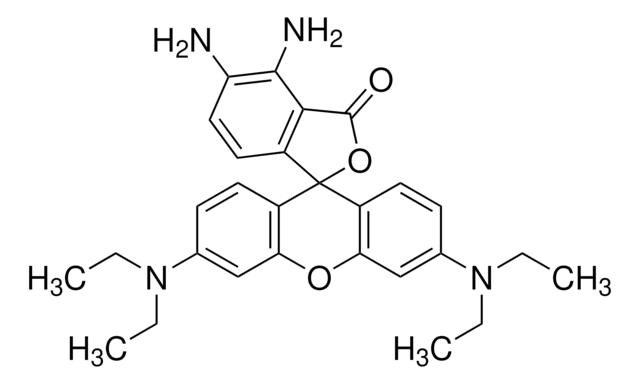C221
Carboxy-PTIO potassium salt
동의어(들):
2-(4-Carboxyphenyl)-4,4,5,5-tetramethylimidazoline-1-oxyl-3-oxide potassium salt, 2-(4-Carboxyphenyl)-4,5-dihydro-4,4,5,5-tetramethyl-1H-imidazol-1-yloxy-3-oxide potassium salt
About This Item
추천 제품
생물학적 소스
synthetic (organic)
Quality Level
분석
≥98% (TLC)
형태
powder
mp
>270 °C
solubility
H2O: 100 mg/mL
DMSO: soluble (lit.)(lit.)
methanol: soluble (lit.)(lit.)
저장 온도
2-8°C
SMILES string
[K+].CC1(C)N([O])C(c2ccc(cc2)C([O-])=O)=[N+]([O-])C1(C)C
InChI
1S/C14H17N2O4.K/c1-13(2)14(3,4)16(20)11(15(13)19)9-5-7-10(8-6-9)12(17)18;/h5-8H,1-4H3,(H,17,18);/q;+1/p-1
InChI key
VYEUQMVIGXFZQU-UHFFFAOYSA-M
유사한 제품을 찾으십니까? 방문 제품 비교 안내
일반 설명
애플리케이션
생화학적/생리학적 작용
Storage Class Code
11 - Combustible Solids
WGK
WGK 3
Flash Point (°F)
Not applicable
Flash Point (°C)
Not applicable
개인 보호 장비
Eyeshields, Gloves, type N95 (US)
시험 성적서(COA)
제품의 로트/배치 번호를 입력하여 시험 성적서(COA)을 검색하십시오. 로트 및 배치 번호는 제품 라벨에 있는 ‘로트’ 또는 ‘배치’라는 용어 뒤에서 찾을 수 있습니다.
이미 열람한 고객
자사의 과학자팀은 생명 과학, 재료 과학, 화학 합성, 크로마토그래피, 분석 및 기타 많은 영역을 포함한 모든 과학 분야에 경험이 있습니다..
고객지원팀으로 연락바랍니다.













